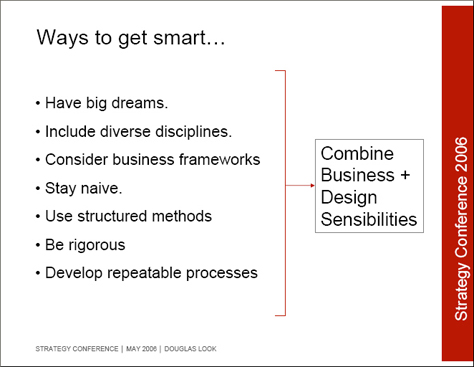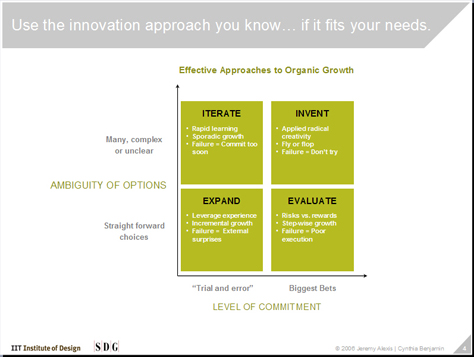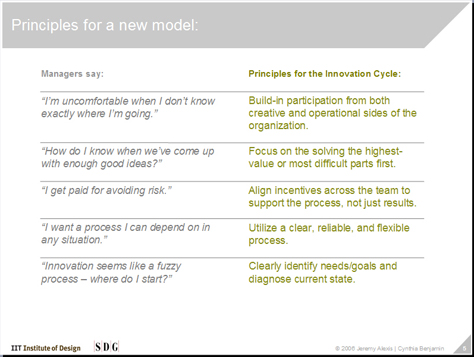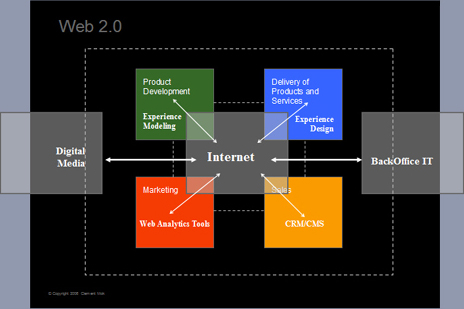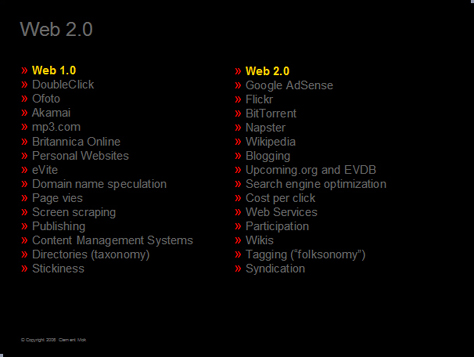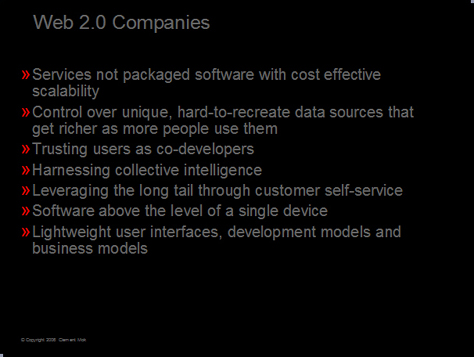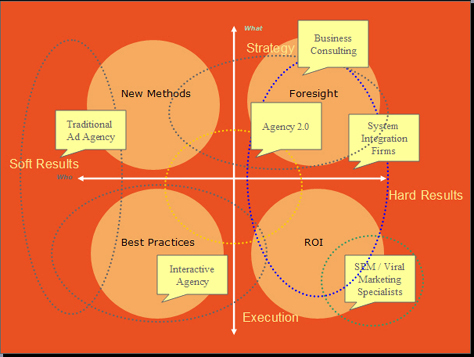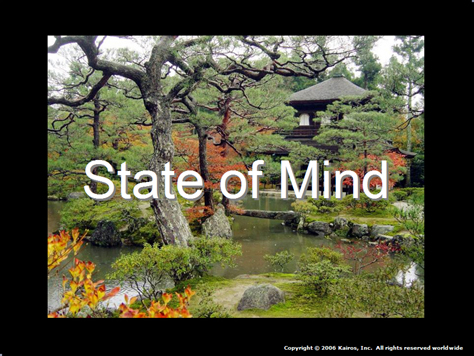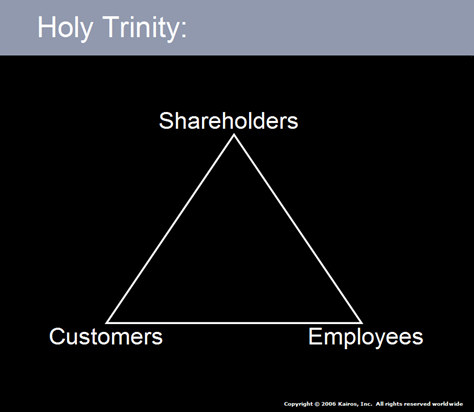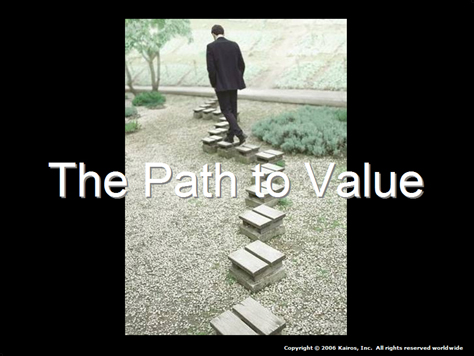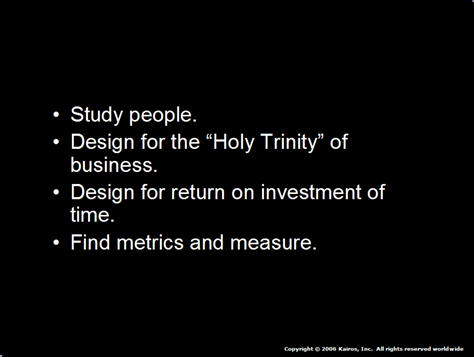The Conference Content
First, I’ll provide an overview of each day of the conference, noting some of the speakers’ more interesting remarks, then describe my favorite talks in detail.
Overview of Day One
- Patrick Whitney, Director of the IIT Institute of Design—On the first day, after a late start due to audio problems, Patrick Whitney, Director of the Institute of Design, opened the conference, characterizing Strategy06 as an “intersection of design, value creation, and strategy.” Not surprisingly, most of the opening remarks focused on design education.
- Christopher Meyer, CEO, Monitor Networks—shown in Figure 1—“Networks, Innovation, Human Capital, and Economic Evolution,” or “Networks: A Theory of Everything”
- Meyer spoke about meme change: “Memes are how management evolves. … Memes are ideas, habits, skills—things we pass from person to person. Competition between memes shapes our society. Networks—electronic or human—transmit memes.”
- Describing how technology moves through our economy, he showed how technology is a predictable progression from science to technology to business to organizations to the information economy.
- According to Meyer, drivers of networked innovation include science, behavior, and most apparently, technology. At their intersection, there is economic opportunity.
- “Social networks are a frontier,” said Meyer. “Networks are enabling processes,” including human networks.
- “Today, there is a shortage of human capital,” said Meyer. Then, he described the value proposition of his company’s WorkNets.
- Rob Forbes, Founder, Design Within Reach
- “Design is the artful arrangement of materials or circumstances into a planned form.”
- “Acquiring and retaining the right customers is our most important business objective. The right customers don’t leave. A well-designed business acquires and retains the right customers.”
- “Google hides complexity behind simplicity. Yahoo! and Amazon have a whole lot of options.”
- “Design has become such a buzz word, but the understanding of it is not so great.”
- Throughout most of his presentation, Forbes spoke about Design Within Reach, a retailer of furniture and objets d’arts, which didn’t really provide information that would be useful to me.
- Roger Martin, Dean, Rotman School of Management, at the University of Toronto—shown in Figure 2—“Designing in Hostile Territory”—This was by far the best talk on Day One. For a review of his talk, see “The Highlight of Day One.”
- Jeffrey Li, President, Novartis China—shown in Figure 3.
- “With innovation, there’s uncertainty you have to face.”
- He offered the following observations about design in China:
- China is shifting from imitation to innovation.
- “It’s a demand-driven economy. There’s overcapacity in everything.”
- “Innovation is a way to stay competitive.”
- “The government is investing in innovation.”
- “There are business incentives to companies innovating.”
- “Quality is a given. Innovation in user experience is a way to make your products unique. That’s a powerful driver of innovation in design.”
- “Chinese companies are developing innovation as a core competency.”
- “The value of design to innovation is increasing.”
- Chinese companies are pursuing “local-branding rather than global-branding strategies,” because there are differences in the Chinese market.
- Li gave one of the more interesting talks of Day One.
- Scott Durschlag, Corporate Vice President, General Manager, Global xProducts, Motorola
- “A cell phone is really a remote control for your life.”
- Figure 4 shows Durschlag’s “Top 10 Consumer Macro Trends.”
- “Time is the most precious commodity. People are more impatient. This creates more complexity.”
- Blogging is a reflection of our self-obsessed culture.
- “We have so much stuff that’s being thrown at us. The velocity of change in information flow is increasing.”
- At Motorola, strategy is grounded in consumer research. In 2006, there will be about 700 million cell phones in use. In 2000, 20% of people surveyed said they couldn’t live without their cell phones; in 2006, 75%.
- In 2005, some of the top brands were Google, Apple, Skype, Nokia, Yahoo!, and Firefox.
- Jim Wicks, Vice President and Director of Consumer Experience Design, Motorola—shown in Figure 5.
- “The basics of design include principles, rules, and branding.” Figure 6 shows Wicks’s design principles for cell phones.
- “Design-driven products focus on defining brand direction.”
- “Motorola is building design strategy into the fabric of the company and locking our design process to group strategy.”
- About management buy-in, Wicks said, “Having to go to the well and ask for permission every time just doesn’t work.”
- Partnering results in collaborative innovations.
- “Business problems are design constraints.”
- “Innovations in how you work are critical over the long term, over many products.”
- Motorola products featured heavily in both Durschlag’s and Wicks’s presentations.
- Carol Coletta, President & CEO, CEOs for Cities, and Master of Design Methods candidate, IIT Institute of Design
- “Women are now in the workforce at the same rate as men.”
- “Cities are in a competition for talent.”
- “Young people are mobile. You have to get them while they’re young. So, if you want to build a new business, you have to attract them. College-educated young people live in cities, within three miles of their workplaces.”
- “Sixty-four percent of people choose a city, then a job.” The most desired attributes of cities are that they be clean and attractive and offer lifestyle choices.
- “Design thinking has so much to contribute to cities. Design and innovation are the only ways to develop new strategies for cities. … Cities need new insights.”
- “Characteristics of successful cities: talented, connected, distinctive, innovative.”
- Todd Tillemans, General Manager, Skin, Unilever, and Chris Conley, Associate Professor, IIT Institute of Design
- “Find a core objective and align behind it. We call this Phase 0.”
- “To address a business problem, broaden your perspective. See things with fresh eyes. Look at both qualitative and quantitative data. Work on projects together. Prototype and pilot test. Prototyping lets professionals with different areas of expertise work together.”
- For transformation to occur, “people must believe change is necessary.”
- Progress from “brainstorming and ideation to rapid prototyping.”
- “Choose momentum over perfection. Do things roughly right, then improve them incrementally.”
- “If you’re not providing thought leadership, you’re resting on your laurels.”
- Panel discussion with Bruce Nussbaum, Assistant Managing Editor, BusinessWeek, and Blaise Zerega, Managing Editor, Condé Nast Business Media—moderated by Patrick Whitney—“Design and Innovation Content in a Business Magazine.” I found this discussion, shown in Figure 7, quite interesting.
- Zerega informed us that, in 2007, Condé Nast will launch a new business magazine, in print and on the Web.
- Zerega: “It’s clear that good design is a competitive advantage, but how do you put a value on good design.”
- Zerega: “With the commoditization of so many goods, companies must innovate to generate value. … We must really understand consumers’ needs.
- Nussbaum: “Innovation is the new black. Everyone is into it, but they don’t know what it is.”
- Nussbaum: “Design has now become a great tool for corporations.”
- Zerega: “Adding openness and collaboration leads to exciting stuff.”
- Zerega: “Condé Nast wants to explore the processes of design thinking.”
- Nussbaum: “We’re sort of at a golden age of design.”
- Nussbaum: “The creative corporation is a big frontier for design and innovation. We must redesign our culture or organizations to make innovation more routine.”
- Nussbaum: “The New York Times doesn’t get design, Forbes doesn’t get anything, and Fortune doesn’t get it either.”
- Nussbaum: “Businesses need to get into the innovation and design space.”
- Zerega: “We’re not in the magazine business, we’re in the content business.
- Nussbaum: “You get more reader feedback from the Web than from a print magazine.”
- Patrick Whitney asked, “What is your primary market?”
- Zerega: “We have the opportunity to provide the kind of coverage only a monthly can do. Someone who reads the business section.”
- Nussbaum: “The innovation and design channel. Innovators in India, China, and Europe. Entrepreneurial people.”
- Nussbaum: “We partner and publish information from others. We go to the smartest people in this business.”
Overall, Day One was somewhat of a disappointment to me. There was quite a lot of self-promotion going on in some presentations. Roger Martin’s great talk was the bright, shining moment of the day. In fact, it was so great, it almost single-handedly redeemed a rather lackluster day. Other high points were Jeffrey Li’s talk and the discussion between Bruce Nussbaum and Blaise Zerega. Nussbaum is a very witty man.
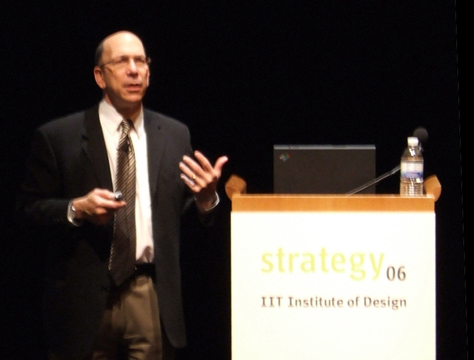
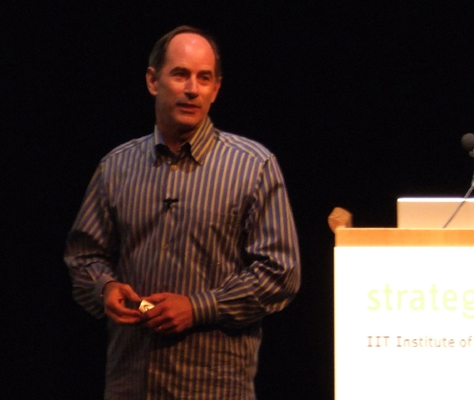
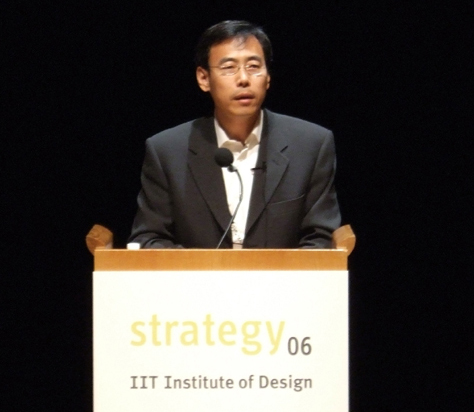
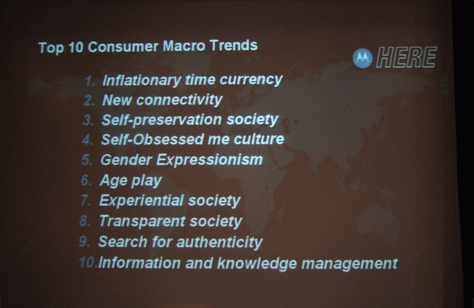
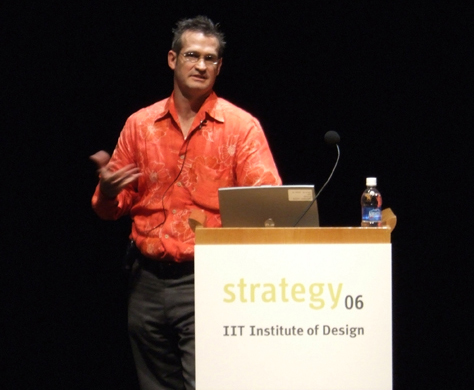
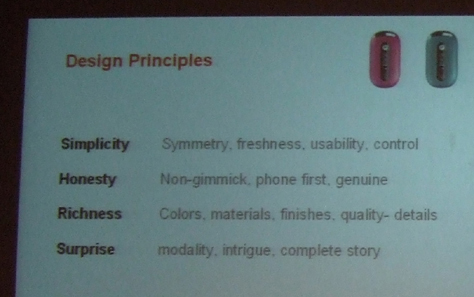
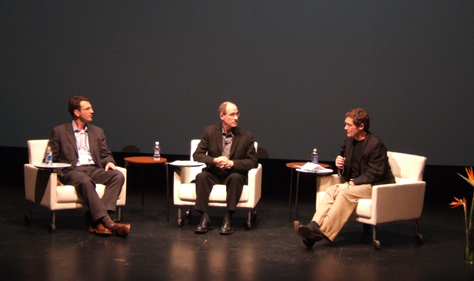
The Highlight of Day One: Roger Martin—“Designing in Hostile Territory”
Roger Martin’s great talk, “Designing in Hostile Territory,” was about designing within organizations that don’t understand design. Martin told us that the root of the problem lies in the fundamental tension between reliability and validity, as shown in Figure 8.
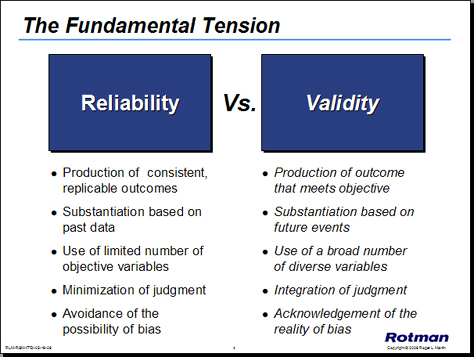
For someone seeking reliability, acceptable bases of proof derive from inductive logic (what is) or deductive logic (what should be), while those for someone seeking validity may derive from inductive, deductive, or abductive logic (what might be). The fact that designers can’t prove future outcomes is the reason they feel that they are in hostile territory when dealing with business people. Business people tend to seek reliability, while designers seek validity. Thus, there is a fundamental predilection gap between business people and designers.
As Figure 9 shows, “there are five things that any designer can do to be successful in hostile territory.”
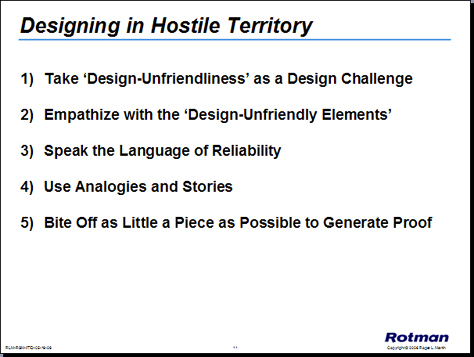
Elaborating on his first point, taking design-unfriendliness as a design challenge, Martin said, “Designers love constraints, because they make design more interesting. Take figuring out how to get something done within an organization as a design challenge.” Martin suggested designers figure out what makes design-unfriendly people that way, because “deep user understanding is the key to design.” To put business people at ease, “speak the language of reliability, regression, proof, and dependability.” The language of design is “perfection, what’s cool, new.” That kind of design language terrifies business people. Because you can’t prove what doesn’t yet exist, use analogies and stories that will help business people imagine success. For example: “Here’s how this is similar…” or “Here’s how another company did something similar.” When attempting to prove something, prove something small.
Martin encouraged business people to “take the innovation challenge.” He told business people not to think “we have to reliably innovate.” You must “remove ‘prove it’ from your lexicon. Empathize. Listen to analogies and stories. To innovate, let a little progress happen.” Then, judge whether a product meets designers’ claims.
Martin told us, “To convince reliability-oriented people to look at things differently, say ‘I understand what you want, but it’s not possible. You must go through the unknown to get to what you want.’” Or say, “If you want to know exactly where you’ll be one year from now, just keep doing what you’re doing.” Nothing will have changed.
Martin said, “We need more validity-oriented CEOs. Design-oriented CEOs are rare. The best CEOs balance the two viewpoints and explicitly understand both.”
